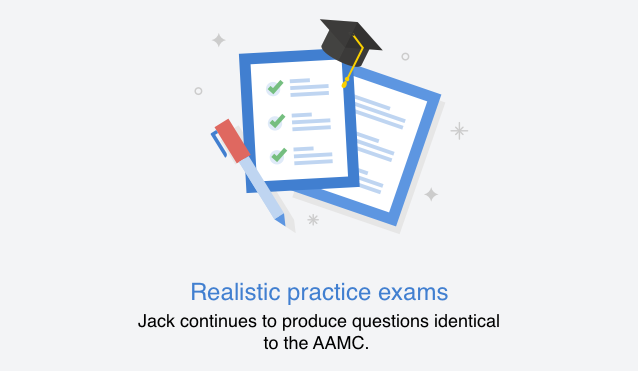Practice Questions
Khan Academy
MCAT Official Prep (AAMC)
Practice Exam 1 B/B Section Passage 2 Question 10
Key Points
• During chemiosmosis, the free energy from the series of reactions that make up the electron transport chain is used to pump hydrogen ions across the membrane, establishing an electrochemical gradient.
• Hydrogen ions in the matrix space can only pass through the inner mitochondrial membrane through a membrane protein called ATP synthase.
• As protons move through ATP synthase, ADP is converted into ATP through the addition of an inorganic phosphate (Pi).
• The production of ATP through the process of chemiosmosis in mitochondria is called oxidative phosphorylation.
Key Terms
Chemiosmotic coupling: The process that links the electron transport chain to the production of ATP through ATP synthase.
ATP synthase: A molecular machine that uses a proton (H+) gradient to form ATP from ADP and inorganic phosphate (Pi).
Electrochemical gradient: The combination of a concentration gradient and electrical gradient due to an unequal distribution of ions across a membrane.
Chemiosmosis: The movement of ions across a selectively permeable membrane, down their electrochemical gradient.
Electron transport chain: A series of proteins embedded in the inner mitochondrial membrane that takes up highly energetic electrons from NADH and FADH2 and uses the energy to form proton gradient across the membrane.

 If the membrane were open to diffusion by the ions, the ions would tend to spontaneously diffuse back across into the matrix, driven by their electrochemical gradient. However, like many other ions, protons can’t pass directly through the phospholipid bilayer of the membrane because its core is too hydrophobic. Instead, hydrogen ions can move down their concentration gradient only with the help of channel proteins that form hydrophilic tunnels across the membrane. In the inner mitochondrial membrane, ions have just one channel available: a membrane-spanning protein known as ATP synthase. Conceptually, ATP synthase is similar to a turbine in a hydroelectric power plant. Instead of being turned by water, it’s turned by the flow of hydrogen ions moving down their electrochemical gradient. As ATP synthase turns, it catalyzes the addition of a phosphate to ADP and the formation of ATP. Take a closer look at the simplified organization and function of the ATP synthase in the figure below.
If the membrane were open to diffusion by the ions, the ions would tend to spontaneously diffuse back across into the matrix, driven by their electrochemical gradient. However, like many other ions, protons can’t pass directly through the phospholipid bilayer of the membrane because its core is too hydrophobic. Instead, hydrogen ions can move down their concentration gradient only with the help of channel proteins that form hydrophilic tunnels across the membrane. In the inner mitochondrial membrane, ions have just one channel available: a membrane-spanning protein known as ATP synthase. Conceptually, ATP synthase is similar to a turbine in a hydroelectric power plant. Instead of being turned by water, it’s turned by the flow of hydrogen ions moving down their electrochemical gradient. As ATP synthase turns, it catalyzes the addition of a phosphate to ADP and the formation of ATP. Take a closer look at the simplified organization and function of the ATP synthase in the figure below.








